Wins and Losses for Chicago Preservation in 2017

1436 W. Berwyn faced demo, but now owned by preservation-minded buyer [John Morris/Chicago Patterns]
As the race to capitalize on this current real estate cycle continues, landmark status is often the only effective tool to preserve historically important structures. Preservation-minded real estate buyers also continue to affect real change in preservation efforts.
Themes this year are similar to the last, with a new look at buildings facing an uncertain future. As always with the end-of-year retrospective, our look at preservation wins and losses is but a small slice of what happened in the past year.
Contributions this year are from Eric Allix Rogers [EAR], Rachel Freundt [RF], Noah Vaughn [NV], John Morris [JM], and Gabriel X. Michael [GXM].
- Changes in 2017
- Buildings Lost or Facing Demolition
- Worker’s Cottages and Italianate Flats
- Italianate Commercial and Mixed-Use Buildings
- Neoclassical and Victorian Era
- Sullivanesque
- Art Deco and Modern
- Landmarks and Other Unique Losses
- Endangered Places
- Saved from Demolition
Changes in 2017
But before getting into specific places, let’s look at a couple of other things that changed in 2017 that will have an impact on historic preservation.
Last year local digital news outfit DNAinfo was abruptly shuttered by its owner. For years DNAinfo served as the only outlet that covered zoning changes, neighborhood meetings, and preservation issues, among others. There were a number of places that were directly or indirectly saved as a result of their objective news coverage.
One of the most visible and direct actions is their coverage of the James von Natta Farmhouse, which led to a reversal of an earlier decision by the owner to demolish it. Countless other stories brought to light by DNAinfo contributed to actions that increased awareness of the importance of historic preservation or led to a positive action.
The Federal Historic Tax Credit is one of the federal government’s most successful and cost-effective community revitalization programs. It has also experienced widespread bipartisan support. The Tax Cuts and Jobs Act retains the 20% Federal Historic Tax Credit, but diminishes its value parceling out the credit over five years. While this doesn’t necessarily mean that historic buildings like the Rosenwald Court Apartments or the Chicago Athletic Association won’t be rehabbed, there is less of an urgent financial incentive to do so.
The bigger loss is the elimination of the 10% pre-1936 “old building” credit, which has fewer restrictions regarding rehabilitation, doesn’t require a building to be traditionally significant, and is widely used across Chicago’s neighborhoods by smaller scale developers and building owners.
Buildings Lost or Facing Demolition
Worker’s Cottages and Italianate Flats

1878 N Orchard [John Morris/Chicago Patterns]

1878 N. Orchard and its much larger neighbors next door. [Rachel Freundt/Chicago Patterns]
Night before its demolition—it's gone now.
We failed 1878 North Orchard Street, we failed Chicago, we failed history. pic.twitter.com/ttAWPYYK70
— Gabriel Xavier Michael (@_GXM) March 1, 2017

334 W Schiller [Gabriel X. Michael/Chicago Patterns]
https://t.co/3pvkUYumkn worker's cottage, 334 West Schiller Street, built 1889. For sale: $1,600,000
— Gabriel Xavier Michael (@_GXM) June 9, 2015
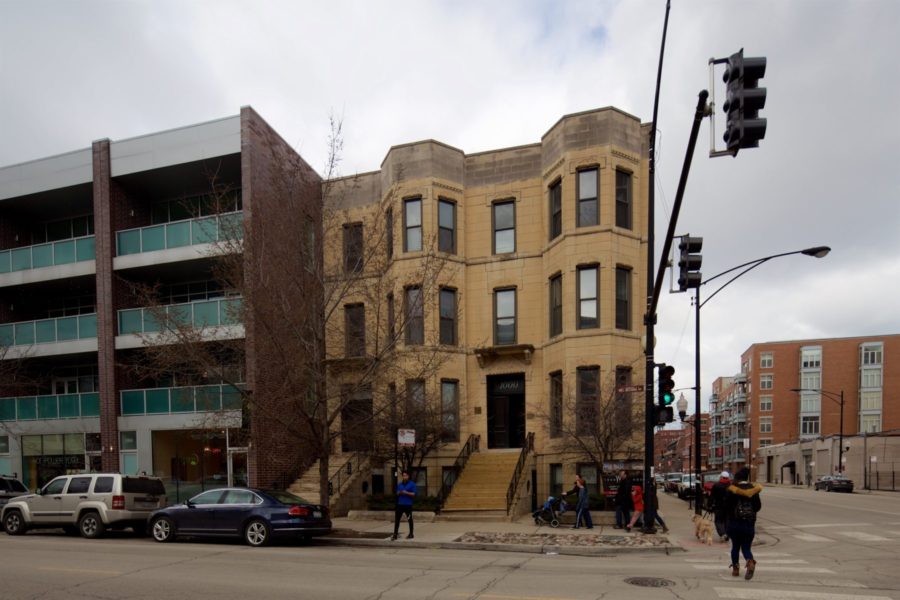
1000 W. Monroe, in March of this year [John Morris]
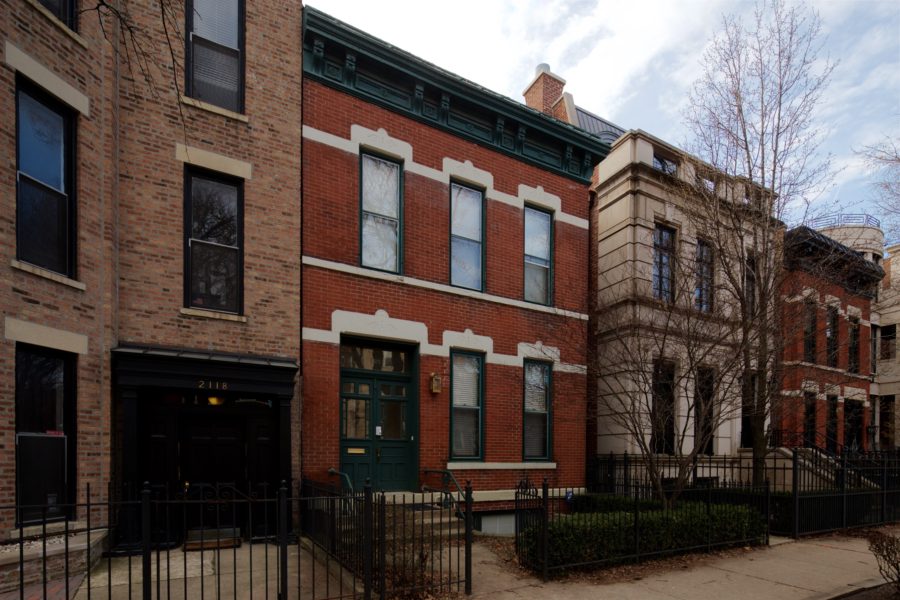
2120 N Seminary
As the race to taller and wider mega-mansions in Lincoln Park heats up, expensive historic homes are being marketed as potential side yards in double-lot sales, such as 2120 N. Seminary above. Fortunately it didn’t become a yard, unfortunately it became a pile of rubble to make way for something much larger. [JM]

2145 N. Fremont. Released from Demolition Delay list over the summer
One of the most potentially disturbing preservation losses this year is 2145 N. Fremont. A lovely example of 19th century multifamily architecture with exquisite and abundant stained glass received a demolition permit this year. The owners of the property live next door, but as of writing there are no construction permits are pending. Did they demolish it just to have a corner side yard? [JM]
have little/no evidence, but have a sinking feeling 2145 N. Fremont will get demolished to give a terrible house a corner side yard pic.twitter.com/zb8dSImFmO
— John Morris (@influxed) October 29, 2017

2136 N Dayton [John Morris/Chicago Patterns]
Lincoln Park, Chicago–where 5,000 square feet of living space, 8 bedrooms, and 6 fireplaces just isn't enough for your lifestyle #teardown pic.twitter.com/hFsznFqL2G
— John Morris (@influxed) October 22, 2017
Reminiscent of the homes in Old Town built in the aftermath of the Great Fire, 1930 N. Sedgwick is of the same era and design. It was built around 1876. This two-unit building has served as a rental property for years, and went on the market with a description that all but said “the value is in the land.”
It won’t be replaced with a single-family home, but it is just one example of the post-fire cottages we’re rapidly losing. [JM]
A pair of frame rowhouses with Italianate bracketed cornices, most likely dating to the late 1860s or early 1870s, received demolition permits in August. Sitting at 464-466 N. Morgan St., they were blocks from Google’s Chicago offices and the nearby Fulton Market redevelopment. [GXM]
2429 W. Augusta (center) facing demolition [John Morris/Chicago Patterns]
Built in the late 1880s, the two-flat features a very high first floor and elaborate incised floral window hoods. It sat on the market for only a few days, before selling for nearly $70,000 above the asking price.

2228 N. Leavitt [John Morris/Chicago Patterns]
But isn't there is already a single family home here @SergioBanks? pic.twitter.com/ES6ZTyUWA9
— Elizabeth Blasius (@blaservations) August 16, 2017

1845 N. Leavitt [John Morris/Chicago Patterns]
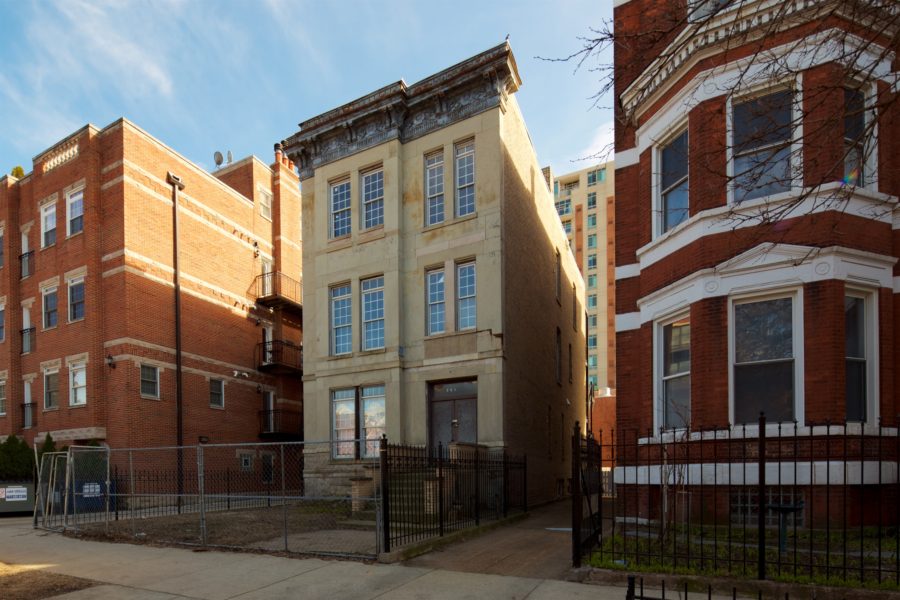
231 W. Scott [John Morris/Chicago Patterns]

2314 N. Leavitt [John Morris/Chicago Patterns]
Advertised as being ideal for SFH or as a duplexed rental on a wide lot, the house sold for $758K and a recent permit reveals that the existing building will get replaced with a new three-flat. [JM]

2219 N. Dayton [John Morris/Chicago Patterns]
This 2-story 2-flat in Lincoln Park is getting demolished and replaced by a 3-story single-family house. https://t.co/AEM5Q6qf44 pic.twitter.com/IBvFc2b3Ss
— Chicago Cityscape (@ChiBuildings) November 19, 2017

26 N Throop [John Morris/Chicago Patterns]

SW corner of Cleveland Avenue and Menomonee Street. [Rachel Freundt/Chicago Patterns]

[Rachel Freundt/Chicago Patterns]
Come on, a storefront attached to the back of a three-flat? Like, you know this kind of charm can never be replicated, right? Ugh. pic.twitter.com/Awvufqqfek
— … (@chi_geek) June 3, 2017
Italianate Commercial and Mixed-Use Buildings
Terra cotta ornament (above) on the south elevation of the J.L. Higgie Building under demolition at 1909 West Ogden Avenue, built late 1880s. [GXM] The neighboring Fantus Clinic building across Harrison Street is also being demolished, joining a wave of new development in the Illinois Medical District. [GXM]
1437 W. Grand Ave. [John Morris/Chicago Patterns]

600 block of N. Milwaukee in 2015 [John Morris/Chicago Patterns]
Looks like these 1870s Italianate storefronts with limestone window hoods are under emergency demolition after a bad fire last week, 695 N. Milwaukee on the left was torn down already (glad I remembered to take this photo last Saturday night) pic.twitter.com/EiG6Hq4fHs
— Gabriel Xavier Michael (@_GXM) November 14, 2017

1144 18th St. [John Morris/Chicago Patterns]
Sadly, neither designation carries enough weight to prevent demolition.
Neoclassical and Victorian
2943 W. Washington Boulevard (left) suffered a fire at the end of 2016, and was recently released from Demolition Delay and issued a demolition permit. It was built in 1903. 2949 (right) is currently for sale by owner at $850,000. [GXM] 1760 West Augusta Boulevard under demolition, replaced by a luxury residential development. While there is an adjacent yet scattered East Village Historic District, this building was not included. [GXM] Along with its neighbor at No. 2521, this Eastlake-style 2-flat frame building was released from Demolition Delay earlier this year and issued a demolition permit in September: 2527 West Medill Avenue, built 1880s [GXM]
Harmony Grill (right) lost in 2017 [John Morris/Chicago Patterns]
Extreme gut rebab on @SouthportCor as @Schubas turns former Harmony Grill into new Tied House. pic.twitter.com/g0PefodbRk
— Chicago Bars (@chicagobars) April 3, 2017

2430 W Moffat [John Morris/Chicago Patterns]
A new three-flat will replace this small but decorative Victorian cottage.
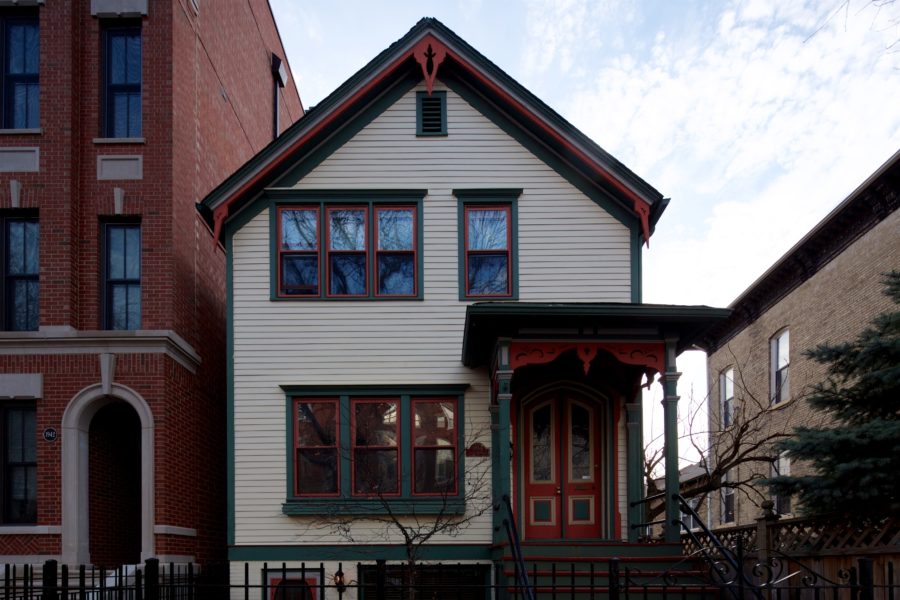
A sad addition to this list is 1944 N. Sedgwick, an exquisitely maintained Gingerbread Gothic in Lincoln Park built around 1876. Standing at three stories and 3,200 square feet, this home was listed on forsalebyowner.com at nearly $1.3 million with the following description:
Rare Single Family home in a fabulous neighborhood; close to the ZOO, Lincoln Park, Lake Michigan, public transportation and great Old Town and Lincoln Park restaurants. And did I mention parking? Two car detached garage. And how about this: We pay our entire mortgage with the vacation rental in the separate garden apartment. The basement is zoned for VRBO if interested in renting that out. But you don’t have to. Use it as a media or family room, an in-law suite or office/ studio. It’s completely renovated with a gleaming new kitchen, bedroom and bathroom.

1944 N Sedgwick [John Morris/Chicago Patterns]

4646 N. Damen in 2015 [John Morris/Chicago Patterns]
Art Deco and Modern

1233 N. Paulina [John Morris/Chicago Patterns]

Decidedly Deco [John Morris/Chicago Patterns]
Say goodbye to this quirky old Wicker Park house. 4-unit condo building on the way, agent tells me. https://t.co/6BOfAXEoat
— Dennis Rodkin (@Dennis_Rodkin) November 9, 2017

1638 N. Sedgwick [John Morris/Chicago Patterns]
After the permit was initially denied at the end of 2016, a demolition permit was eventually granted in August of this year. [JM]

General Growth Building [John Morris/Chicago Patterns]
Sullivanesque

Sullivanesque terra cotta lost forever [John Morris/Chicago Patterns]
Finally, Nick’s Pizza & Pub in Lincoln Square is officially open! #nickspizzalincolnsquare #pizzaonpurpose https://t.co/aQLghrvylp pic.twitter.com/113qI0RIfZ
— Nick's Pizza & Pub (@Nickspizza) October 24, 2017

[Ward Miller/Preservation Chicago]
Two new four-story mixed use buildings are being developed by BlitzLake Partners and designed by Piekarz Associates. Though Preservation Chicago, Allan Mellis and community partners were unable to prevent the demolition of the Lincoln-Montana Building, we were able to ensure through a signed community development agreement that the building’s decorative ornamental “Sullivanesque” terra-cotta would be carefully removed and donated to the Illinois Railway Museum in Union, Illinois, where it will be incorporated into the façade of their new visitors center and part of its new $7.5 million, two-block Vintage Main Street exhibit.
After long effort, Historic Lincoln-Montana demo today with ornamental terra cotta to be saved by @Pres_Chicago & Illinois Railway Museum. pic.twitter.com/SUay8e8l8T
— Preservation Chicago (@Pres_Chicago) July 24, 2017

[Ward Miller/Preservation Chicago]
Landmarks and Other Noteworthy Losses
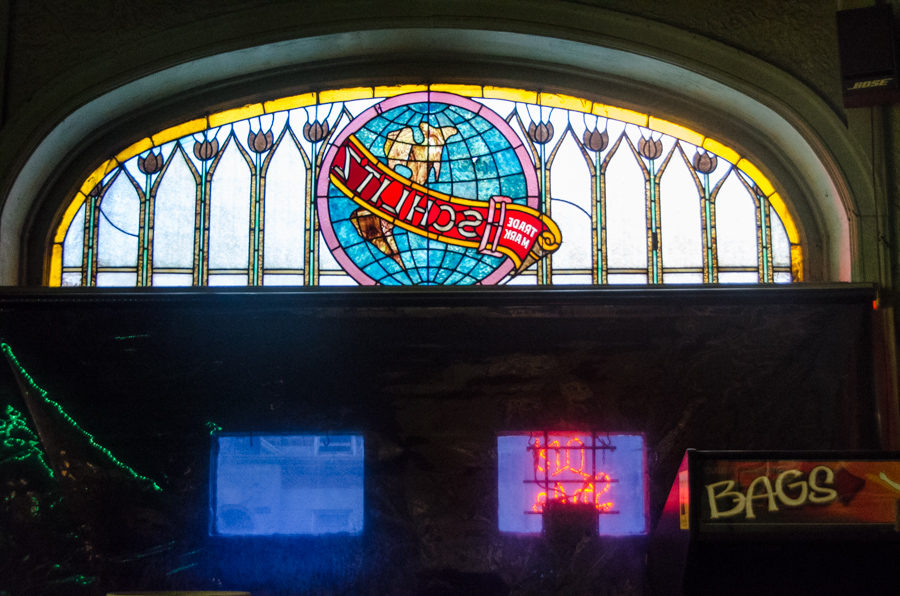
Bamboo Lounge [Eric Allix Rogers/Chicago Patterns]

56 W. Huron [John Morris/Chicago Patterns]
The congregation remained at 56 W. Huron until they relocated to a larger building in 1948, with the old church reverting to other uses not long after. [JM]

August 1960 Chicago Daily Tribune, showing interior space of 56 W. Huron
In 1960 a Tribune article (above) shows the space in use for artists and designers.
It was most recently in the news as the preferred salon of Michelle Obama:
The hair salon Michelle Obama frequented for more than 20 years before moving to Washington may soon be replaced with an 11-story condo building.
A development entity headed by Joseph Kiferbaum of Adama Associates in Deerfield last week filed an application for a zoning change for a project at 56 W. Huron, the site of Van Cleef Hair Studio. Michelle Obama had her hair done by its proprietor, Michael “Rahni” Flowers, from the time she was 18, in 1986, until after her husband was elected president.
–Dennis Rodkin, Crain’s Chicago Business

Noble Horse Theater [John Morris/Chicago Patterns]

Noble Horse Theater [John Morris/Chicago Patterns]

[Rachel Freundt/Chicago Patterns]

1217-1227 W. Washington Boulevard [Rachel Freundt/Chicago Patterns]
1217 W. Washington Boulevard was released from Demolition Delay List yesterday. Happy Thanksgiving. pic.twitter.com/jweUnuFzQx
— Gabriel Xavier Michael (@_GXM) November 22, 2017

1217 W. Washington Boulevard [Gabriel X. Michael/Chicago Patterns]

1648 N. Winchester [John Morris/Chicago Patterns]
Upzoned to allow a larger single family house? Near Damen Blue Line, former trolley garage at 1648 N. Winchester faces demolition pic.twitter.com/3adQoi72Mv
— Chicago Patterns (@chicagopatterns) December 17, 2017

Randolph and Wabash station [John Morris/Chicago Patterns]
mezzanine catwalk, final day of service at the @cta Randolph/Wabash station, opened in 1896 pic.twitter.com/xj3M0WfUvG
— Gabriel Xavier Michael (@_GXM) October 8, 2017

[John Morris/Chicago Patterns]

South Side Masonic Temple [Eric Allix Rogers/Chicago Patterns]

c Sixty Third State Bank, 2015 [Noah Vaughn]

[Eric Allix Rogers/Chicago Patterns]

Sixty Third State Bank during demolition [Noah Vaughn]

1450 N. Dayton Street [Rachel Freundt/Chicago Patterns]

Southern side of 1450 N. Dayton Street during its demolition. [Rachel Freundt/Chicago Patterns]

1443 North Wells [Rachel Freundt/Chicago Patterns]
Endangered Places
![[Eric Allix Rogers/Chicago Patterns]](http://chicagopatterns.com/wp-content/uploads/2017/07/sanctuary-6-900x596.jpg)
[Eric Allix Rogers/Chicago Patterns]

Woodruff Arcade [Stephanie Barto/Chicago Patterns]

Woodruff Arcade [Stephanie Barto/Chicago Patterns]
A seven-story development slated to replace Edgewater’s 1923 Woodruff Arcade at the southeast corner of Sheridan Road and Devon Avenue is apparently back with an updated design. The mixed-use project calls for 58 rental apartments above 9,000 square feet of ground floor commercial space and could be delivered by fall 2018, according to latest information commercial real estate brokerage firm Edgemark.
— Jay Koziarz, Curbed Chicago
The Edgewater Historical Society puts a fine point on its value and why it deserves landmark status:
The Woodruff Arcade is a hidden gem, but a gem nonetheless. It is a unique building type, the precursor of today’s indoor shopping mall, and it is the only one in Edgewater (we once had two). More importantly, it is the only one in all of Chicago. For that reason alone it should be preserved.
— Edgewater Historical Society

3301 N Albany [Gabriel X. Michael/Chicago Patterns]
Then and Now: former Avondale Presbyterian Church built in a Queen Anne/Shingle style with a fantastic gabled roofline, 3301 N. Albany Avenue, built 1891 (undated/uncredited postcard). Vacant building currently under threat of demolition for proposed 6-flat development. pic.twitter.com/ZYk1UMVrCk
— Gabriel Xavier Michael (@_GXM) December 12, 2017

Wing Hoe Restaurant at 5356 N. Sheridan [John Morris/Chicago Patterns]
The building, which has housed Wing Hoe Chinese restaurant since 1971, was turned into a commercial building in 1947. It originally housed the famous Joe Stein’s Romanian Steak House which began operation sometime in 1948-1950. After Joe died in 1969, Wing Hoe took over the space and has served the neighborhood for almost a half-century – which is an incredible feat.
It is most likely that the mansions updated role as a commercial property is the reason it has survived so long. But now that Edgewater is a hot real estate market again, developers can make a nice profit with the complex that has been proposed. A huge lot, easy demolition and low selling price can make a structure like the 5356 N. Sheridan mansion vulnerable to developments.
–Edgeville Buzz

Newel posts at 5356 N. Sheridan [John Morris/Chicago Patterns]
One of #Edgewater's last surviving Sheridan Rd. mansions and Wing Hoe Restaurant could be no more. https://t.co/QOmZeYahzw pic.twitter.com/F9YPMo1e2h
— EdgevilleBUZZ (@EdgevilleBUZZ) December 19, 2017
Saved from Likely Demolition
![154 W. Superior St. [Eric Allix Rogers/Chicago Patterns]](http://chicagopatterns.com/wp-content/uploads/2017/07/ericallixrogers-superior-2-900x702.jpg)
154 W. Superior St. [Eric Allix Rogers/Chicago Patterns]

1639 N. North Park Avenue [John Morris/Chicago Patterns]
The representatives of the owner’s estate applied for a demolition permit in September, 2016. The Commission reviewed their request at their October 2016 meeting and preliminarily disapproved the application based on their determination that the home is contributing to the district. An informal conference was held in November. The applicant then requested an economic hardship hearing. They agreed to extend the deadlines for this hearing, which occurred in April and was continued to four additional dates, concluding in July of 2017. The Commission issued their denial of the economic hardship application in September, 2017.
–Planning, Design, and Historic Preservation Division, City of Chicago

Once facing demolition, now in the hands of a caring owner: 1436 W. Berwyn [John Morris/Chicago Patterns]

Downspouts and arch light resembling a face at 1436 W Berwyn [John Morris/Chicago Patterns]
This is a good example of what an organized community can accomplish. The Alderman held a meeting, hundreds showed up, he turned against the project, and eventually the developer decided to sell.
— Andy Marfia (@AndyMarfia) January 1, 2018

2700 N. Lakeview [Eric Allix Rogers/Chicago Patterns]

Vautravers Building [John Morris/Chicago Patterns]
After an uncertain future, CTA now appears set to preserve it by relocating it. [JM]

4636 N. Paulina [Rachel Freundt/Chicago Patterns]
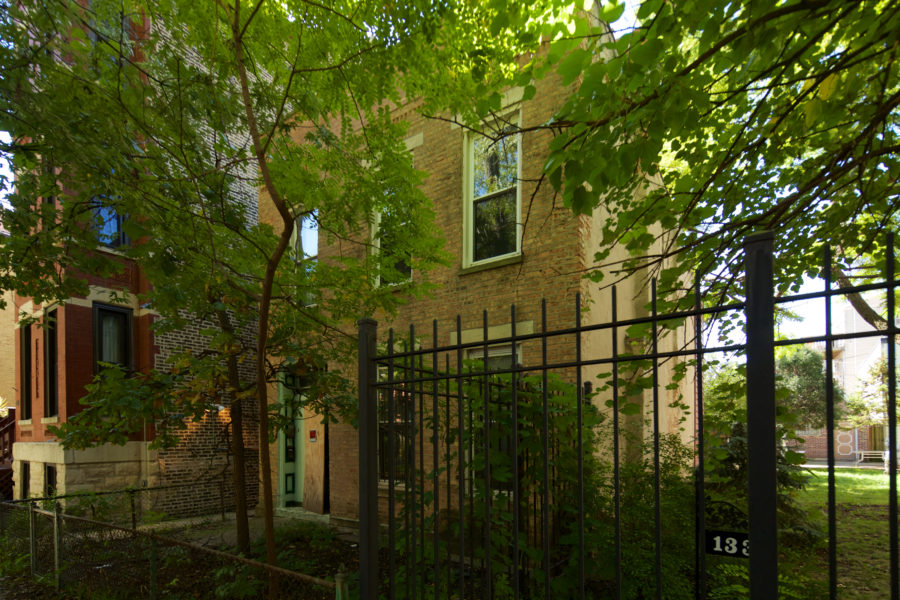
1328 W. Wicker Park Avenue [John Morris/Chicago Patterns]
In October of 2016 a demolition application was received for this building. It had been vacant for several years and the demolition was requested by the estate of the deceased owner. In November the Commission on Chicago landmarks determined that the building is a contributing structure to the Wicker Park District and its demolition would constitute an adverse effect. A preliminary decision disapproving the demolition application was issued. In March the owner chose to withdraw the demolition application and put the property back on the market. In April the Historic Preservation Division received a permit application for substantial repairs and a rear addition.
–Planning, Design, and Historic Preservation Division, City of Chicago

Daniel O. Hill House [Rachel Freundt/Chicago Patterns]

958 W. 69th [John Morris/Chicago Patterns]
In March, an out-of-state property owner decided the easiest way to remediate building violations was a demolition permit. The Planning, Design, and Historic Preservation Division stepped into action and explained landmark status to the owner, and suggested transfer to a local non-profit. The property owner agreed to defer the initial demolition request and talks are ongoing.

Pediment detail, 958 W. 69th in Englewood [John Morris/Chicago Patterns]
Closing Thoughts
One important lesson of 2017 is the power of historic landmarks and landmark districts. It’s a great sign that preservation-minded buyers are saving numerous homes on the market listed as “teardown opportunities.” But to make for an even better landscape for historic building stock, we need more individual landmarks and landmark districts.
As we’ve seen in some of the buildings spared demolition in 2017, a building’s landmark status with the city can make all the difference.
Preservation Chicago is on the case, but needs your help to make it happen. [JM]
How about a Chicago Blues Historic District! https://t.co/IbdWOjsJ9o
— Preservation Chicago (@Pres_Chicago) June 8, 2017
Any movement towards a Chicago Public Sculpture Landmark District to protect our public art? https://t.co/YdTXAbZHYz
— Preservation Chicago (@Pres_Chicago) November 30, 2017
Pilsen needs a Historic Landmark District to preserve neighborhood architecture, & as a planning tool for new construction & gentrification. https://t.co/AVxc88Hq9t
— Preservation Chicago (@Pres_Chicago) August 8, 2017
Previous Yearly Retrospectives
Our 2017 Articles on Preservation
- Why save the South Shore Nature Sanctuary?
- 63rd Street Heyday’s Remnants at Risk as Woodlawn Development Takes Off
- Dual Landmark Status Not Enough to Save Building in Pilsen
- The Value is in the Land: Lincoln Park Italianate Edition
- The Emergence, Demolition, and Preservation of Italianate Cottages and Flats
- The Value is in the Land: 1000 W. Monroe
- Beautiful 19th Century Homes on Borrowed Time
- Preservation Chicago’s 2017 “Chicago 7” Most Endangered List
- The Bamboo Lounge














1878 N. Orchard, I’m really missing you:(